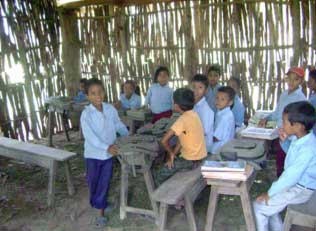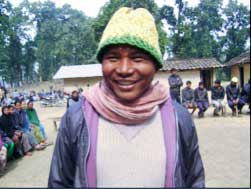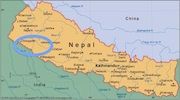The Primary School in Dhurjhanna was completed on June 9, 2012!

The New Primary School in Dhurjhanna
Dhurjhanna Community Profile
Dhurjhanna is part of the Urma VDC (Village Development Committee) in the Kailali District of far western Nepal. This community was founded about 200 years ago by Mr. Mathura Rana. Today there are 1,675 people living in Dhurjhanna. All of them follow a form of the Hindu religion, and 80% belong to the Tharu ethnic group. The Tharu make up about 6.5% of Nepal’s total population. Until the practice was banned in 2000, many Tharu were forced into a form of indentured servitude called Kamaiya. Of the 215 families lin Dhurjhanna, 35 are ex-Kamaiya. Dhurjhanna is 8 km from the buildOn office in Dhangadhi, where the closest hospital is also located. There are two rivers near Dhurjhanna- Khutiya to the west and Shivaganga to the east. The elected leaders of the community are Mr. Bhanu Ram Chaudhary and Mr. Anupam Chaudhary. Agriculture is the primary income generating activity in Dhurjhanna. Families grow rice, wheat, oilseed, and vegetables. The climate is warm for most of the year, with cooler temperatures from November to January and the heaviest rains from June to August.
The Old School

An Old Classroom

A New Classroom
Kalika Samudayik Primary School
There were no permanent classrooms in Dhurjhanna prior to this project, so the students studied in buildings made of wood and mud. These temporary structures are easily damaged during the monsoon season. Many students also attended classes outdoors and, after finishing primary school, some walked about 2km to another community (Patthariya) to continue their education. There are currently 133 students enrolled in Kalika Samudayik Primary School- 74 girls and 59 boys. They study with 5 teachers in grades 1 through 5. This school was formally established just 7 years ago.
There were no permanent classrooms in Dhurjhanna prior to this project, so the students studied in buildings made of wood and mud. These temporary structures are easily damaged during the monsoon season. Many students also attended classes outdoors and, after finishing primary school, some walked about 2km to another community (Patthariya) to continue their education. There are currently 133 students enrolled in Kalika Samudayik Primary School- 74 girls and 59 boys. They study with 5 teachers in grades 1 through 5. This school was formally established just 7 years ago.
Dhurjhanna School Project
The buildOn school block in Dhurjhanna has 3 classrooms as well as 2 latrines. It has been furnished with desks and seats and permanent chalkboards. Students began using the new school in August 2012. In September, parents and grandparents began attending buildOn’s Adult Literacy Program. Through the promotion of basic education, this program addresses the problems of poverty, disease and injustice. In each class, adult students spend the first six to twelve months learning to read, write and do basic math through the lens of health, agriculture, and relevant life skills. Participants then put these skills to the test through income generating activities. Local program facilitators are trained by buildOn and receive a monthly stipend to teach adults six nights per week, two hours a night, for six months a year (villagers take school breaks during farming and holiday seasons) over a three year period.
This Dhurjhanna school project broke ground on February 14th 2012 and was completed on June 9th 2012. The people of Dhurjhanna contributed a total of 1,590 volunteer workdays to the project over the course of 14 weeks. Construction slowed to a crawl for several weeks because a strike blocked major roads and prevented the delivery of materials- but once the strike ended, the community quickly started working again. Before beginning construction they also collected local materials for the project and met with buildOn staff to sign a covenant outlining the following responsibilities:
Community Contribution
• Unskilled labor: 20 workers (10 women and 10 men) per day, six days per week
• Commitment to educating girls and boys equally
• The land on which the school will be built
• High quality local materials: sand, gravel, water & rocks
• Volunteer management committee made up of 12 villagers (six women, six men)
• Lodging for buildOn Field Coordinator and skilled laborers in local homes
• Basic construction tools (picks, buckets, etc.) when available
buildOn Contribution
• Engineering and architecture
• Construction materials (excluding local materials) for school and latrine
• Skilled labor and plans needed to build the school
• Project management (buildOn coordinators)
• Instruction in basic construction techniques
• School furniture
This Dhurjhanna school project broke ground on February 14th 2012 and was completed on June 9th 2012. The people of Dhurjhanna contributed a total of 1,590 volunteer workdays to the project over the course of 14 weeks. Construction slowed to a crawl for several weeks because a strike blocked major roads and prevented the delivery of materials- but once the strike ended, the community quickly started working again. Before beginning construction they also collected local materials for the project and met with buildOn staff to sign a covenant outlining the following responsibilities:
Community Contribution
• Unskilled labor: 20 workers (10 women and 10 men) per day, six days per week
• Commitment to educating girls and boys equally
• The land on which the school will be built
• High quality local materials: sand, gravel, water & rocks
• Volunteer management committee made up of 12 villagers (six women, six men)
• Lodging for buildOn Field Coordinator and skilled laborers in local homes
• Basic construction tools (picks, buckets, etc.) when available
buildOn Contribution
• Engineering and architecture
• Construction materials (excluding local materials) for school and latrine
• Skilled labor and plans needed to build the school
• Project management (buildOn coordinators)
• Instruction in basic construction techniques
• School furniture

The Teachers

A Community Meeting
Without proper education nobody can do any work perfectly. Education means development, so every development depends on education. Without education, life is dark.
- Mr. Bhanu Ram Chaudhary

